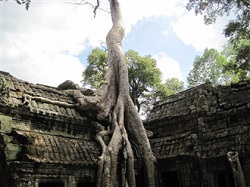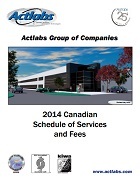Actlabs
Biogeochemistry
 Humus and vegetation has been used very successfully to discover buried mineralization. The trees act as minidrills with their root structures sampling very large volumes of soil and in the case of phreatophytes the root stucture searches out the water table and may extend hundreds of metres below the surface. Generally in the case of humus (decaying surface vegetation) the material is dried below 60 degrees C and then macerated in a cutting mill with a 1 mm internal sieve. The ground material can be compressed into a briquette for neutron activation (code 2A) or ashed and analyzed by digestion and ICP or ICP/MS. Vegetation can also be dried and ground in a cutting mill to homogenize it. Subsequently it can ba analyzed by compressing into a briquette (code 2B) by ashing anand analysis of the ash (code 2C, Code 2C1, code 2D and code 2E). The choice of package depends on the elements and detection limits required. The ground vegetation can also be analyzed directly by digestion and analysis by high resolution ICP/MS (Code 2F or code 2F-PGE.
Humus and vegetation has been used very successfully to discover buried mineralization. The trees act as minidrills with their root structures sampling very large volumes of soil and in the case of phreatophytes the root stucture searches out the water table and may extend hundreds of metres below the surface. Generally in the case of humus (decaying surface vegetation) the material is dried below 60 degrees C and then macerated in a cutting mill with a 1 mm internal sieve. The ground material can be compressed into a briquette for neutron activation (code 2A) or ashed and analyzed by digestion and ICP or ICP/MS. Vegetation can also be dried and ground in a cutting mill to homogenize it. Subsequently it can ba analyzed by compressing into a briquette (code 2B) by ashing anand analysis of the ash (code 2C, Code 2C1, code 2D and code 2E). The choice of package depends on the elements and detection limits required. The ground vegetation can also be analyzed directly by digestion and analysis by high resolution ICP/MS (Code 2F or code 2F-PGE.

|
Sample Preparation Technician - Ancaster, Ontario
Sample Preparation Technicians will be working with rocks and preparing them for analysis.
Fire Assay Technician
Activation Laboratories Ltd. (Actlabs)was established in 1987 and is one of Canada’s premier service laboratories supporting a vast array of clients. With head office situated in Ancaster Ontario, Actlabs provides services in over 90 countries and has several strategically positioned facilities that support global markets. We are recognized throughout the world as a leader in analytical testing, development services and delivering quality analysis. Actlabs provides analysis in the geoche